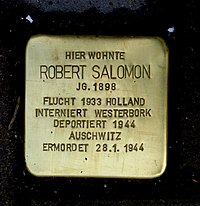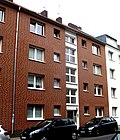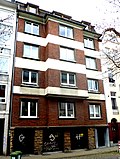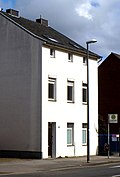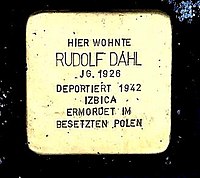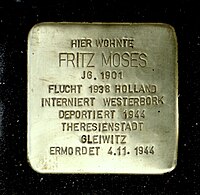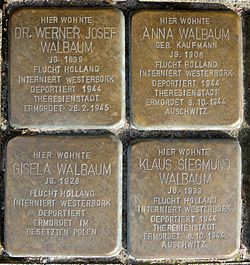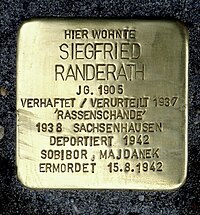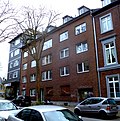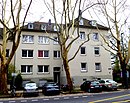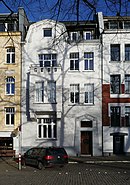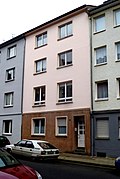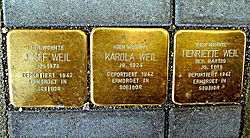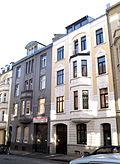List of stumbling blocks in Aachen
The Stolpersteine campaign by the artist Gunter Demnig aroused great interest in Aachen in 2008 . The City Council of Aachen decided to honor the memory of former citizens who were deported, murdered or forced to flee from Germany in the Third Reich with such a memorial stone. These small brass cuboids with the engraving of the name, the dates of life and the fate are located in front of the last vacant house of the person concerned and were put into the sidewalk by the artist himself.
In this campaign, which has existed in more than 300 towns in Germany, Austria, Hungary and the Netherlands since 2003, in Aachen, under the overall organizational management of the Volkshochschule Aachen, a number of private individuals and the memorial book project, in particular, many schools in Aachen took part. As part of their lesson plan, they researched the life stories of the people affected, made contacts with survivors and, last but not least, donated the costs of currently 120 euros per stone from the proceeds of the so-called “peace runs”. In addition, some schools and clubs sponsored selected stumbling blocks.
Since 2008, 66 stumbling blocks have been laid at 39 addresses on the following eight dates:
- January 16, 2008: nine stones at five addresses
- June 15, 2009: fourteen stones at five addresses
- December 3, 2010: a stone to an address
- October 18, 2011: two stones to one address
- December 17, 2012: seven stones at five addresses
- June 15, 2016: eighteen stones at nine addresses
- February 1, 2018: eight stones at two addresses
- February 6, 2019: seven stones at seven addresses
The people who have been honored with stumbling blocks so far include Jews or people of Jewish descent as well as two politically persecuted persons and a disabled child.
Overview
The location pictures show the residential area in 2019. Several houses did not exist before 1945
Map with all coordinates: OSM | WikiMap![]()
| address | Name and details | Installation date and sponsorship | image |
|---|---|---|---|
| Adalbertstrasse 33 ( location ) |
Lina Levano , b. Bauer (born November 12, 1887 in Weilburg an der Lahn ) was the tenth of twelve children of a cattle dealer. She worked as a shoe seller and took over after her marriage to Eduard Levano (1883–1933) in 1912 together with him and her sister Clementine Katzenstein, née. Bauer (born on 1875), the Louis Berg shoe store in Aachen, which they ran until 1928. Then the Levano family opened a new shoe shop under the name Bauer Schuh & Co. In 1942 Lina Levano was deported to Riga and murdered there.
Her son Günter Levano (born May 2, 1927 in Aachen) was first deported to Riga in 1942, then transferred to the Stutthof concentration camp and murdered in 1944 in the Magda satellite camp of the Buchenwald concentration camp in Magdeburg . |
17th December 2012 | |
| Adalbertstrasse 43 ( location ) |
Clementine Katzenstein , b. Bauer (born on May 25, 1875 Weilburg an der Lahn) was Lina Levano's sister and, together with her sister and her husband Eduard Levano, took over the Louis Berg shoe shop in Aachen, which they ran until 1928. Then the Levano / Katzenstein family opened a new shoe shop under the name Bauer Schuh & Co. In 1939 she fled to Belgium, where she was arrested and interned in the Mechelen assembly camp. On October 10, 1942, Katzenstein was deported to the Auschwitz concentration camp and murdered there. | 17th December 2012 | |
| Alt-Haarener Strasse 20, Aachen-Haaren ( location ) (originally planned for Weißenburger Straße 40 according to city resolution) |
Hugo Hartog (born on January 30, 1886 in Aachen), son of the butcher Abraham Hartog and his wife Sara born. Kamp, lived in Aachen and worked as a cattle dealer. On January 12, 1939, he fled with his family to Rotterdam , was interned as a German in May 1939 and died in the bombing raid on Rotterdam in 1940.
His wife Emma Hartog , b. Moses (born on March 1, 1886 in Weilerswist ), daughter of Tobias Moses and Josephina, b. Schweitzer, initially lived in Haaren. She emigrated with her husband to Rotterdam on January 12, 1939 and was deported from the Westerbork transit camp to the Theresienstadt concentration camp on January 18, 1944 , finally transferred to Auschwitz on October 28, 1944, and died there on October 30, 1944. Her three children Fritz (1913–1985), Kurt (1919–2005) and Edith († 2009) survived, with Fritz being included in the list of Schindler Jews. |
June 15, 2016 | more pictures |
| Alt-Haarener Strasse 191, Aachen-Haaren ( location ) |
Albert Levy (born March 15, 1885 in Aachen-Haaren) was the son of the cattle dealer Jacob Levy (1844–1928) and Sibylla, b. Breuer (1856–1940) and cousin of Albert Levy (born December 24, 1883) from Friedensstrasse and Wilhelm Sigismund Levy (born February 14, 1871) from An den Frauenbrüdern . Albert Lvy worked as a merchant and cattle dealer in Aachen. Around 1940 he was sent to the Rhenaniastraße forced labor camp in Stolberg , which was closed on June 15, 1942. Levy, like all inmates, was then deported east to the Sobibor extermination camp , where he was murdered.
Albert Levy's wife Selma Levy , b. Simon (born on the 19th century) came with her children Helga Levy (born on February 23, 1930 in Haaren) and Else Levy (born on March 28, 1931 in Haaren), who previously attended the municipal Israelitische Volksschule in Aachen and with Albert's sister Henriette Levy (born October 11, 1888 in Haaren), who lived in their house, initially to the Hergelsmühle camp in Haaren. From there they were deported to the Theresienstadt concentration camp on July 25, 1942, where they were murdered. |
June 15, 2016 | more pictures |
| To the women brothers 4 ( location ) |
Sibylla (Bella) Levy , b. Rubens (born November 22, 1876 in Pannesheide ), daughter of Andreas Rubens and Regina Marx, was the wife of Wilhelm Sigismund Levy (born February 14, 1871 in Jülich ). He was the son of Bernhard Levy (born August 31, 1838) and Clara Pinnes (born September 4, 1830) and the cousin of Albert Levy (born March 15, 1885) from Alt-Haarener Strasse and Albert Levy (born December 24, 1883) from Friedensstrasse in Haaren. It is only known that he was an invalid in 1938. Sibylla was deported from Düsseldorf to the Theresienstadt concentration camp on July 25, 1942 and transferred to the Treblinka extermination camp on September 21, 1942 . The Aachen District Court declared her dead on November 19, 1957 and set the date of death to December 31, 1945.
Only their youngest daughter Else (born on 1915) escaped to England, while the other two daughters Clare (born on April 11, 1910; died on February 11, 1944 in Auschwitz) and Erna (born on March 15, 1911 ; died 1943 in Lublin) became victims of the Shoah. |
June 15, 2016 | |
| Aretzstraße 7 Rehmviertel ( location ) |
Hans Max Silberberg (born May 24, 1927 in Aachen), son of the butcher Hermann Silberberg (1891–1942 in Sobibor) and Sophie, née Hirsch (1893–1942 in Sobibor), was a football player at Alemannia Aachen . On May 4, 1942 he was arrested and transferred to the Rhenaniastraße camp in Stolberg as a forced laborer . From there he was deported on June 15, 1942 via Koblenz, Cologne and Düsseldorf, first to the Sobibor extermination camp and then to the Majdanek concentration camp , where he was murdered on August 8, 1942. | February 6, 2019 IG of Alemannia Fans and Fan Club eV |
|
| Augustastraße 12 Steffensviertel ( location ) |
Paul Maas (born on March 24, 1873 in Trier ) came to Aachen after studying medicine and completing his doctorate in Bonn in 1896 , where he initially worked as a specialist in ear, nose and throat ailments and language disorders at the institute for people with language disorders and the mentally retarded Dahmengraben settled down.
In Aachen he married Ida Maas , née Kamp (born on July 2, 1875 in Aachen), with whom he later moved into the house he had bought at Augustastraße 12, in which he set up his practice from 1922 and where he lived up to practiced his professional ban in 1933. On May 15, 1941, the Maas couple were forcibly transferred to the already overcrowded Kalverbenden Jewish old people's home, then Horst-Wessel-Strasse, in Burtscheid , from where they were to be deported to the Sobibor concentration camp on June 15, 1942. The couple evaded this evacuation the day before on June 14, 1942 by self-determined suicide, which was briefly sent to the in a farewell letter written by the flatmate of the home Anna Amberg (see: Salierallee 7 ), who was also on the deportation list common acquaintance Otto Blumenthal could be sent.Stolpersteine for Paul Maas and ten other Jewish high school graduates from the Friedrich-Wilhelm-Gymnasium there were laid at Jesuitenstrasse 13 in Trier in 2014 . |
||
| Augustastraße 37, Steffensviertel ( location ) |
Helene Hornberg , b. Levi (born November 1, 1878 in Ratingen ), daughter of the butcher Joseph Levy (1843–1937) and Sophia, née Heumann (1844–1928), was married to the butcher and meat wholesaler Siegmund Hornberg (born 4. August 1864 in Aachen), son of the butcher Joseph Nathan Hornberg (born on July 15, 1825) from Elsdorf and Klara, born in Vitten (born on February 23, 1820) from Jülich. Both were deported to Theresienstadt concentration camp on July 25, 1942 and to the Treblinka extermination camp on September 26, 1942 , where they perished. | October 18, 2011 | more pictures |
| Bärenstrasse 7 ( location ) |
Marie Ahn (born July 12, 1908 in Lontzen / Belgium) was the daughter of the royal Prussian railway employee Theodor Ahn (1875–1943) and Marie Therese Wilhelmine Mennicken (1879–1961). Theodor Ahn moved with his family to Aachen in 1920 because he wanted to maintain and secure his position as Reichsbahn shunting master in Prussia after his homeland was annexed to Belgium due to the Versailles Treaty .
His daughter Marie apparently suffered from mental disorders from around the age of 12 and was then forcibly sterilized in 1935 . In 1939, she was transferred to the Düren sanatorium and nursing home . From there, on July 11, 1941, she was temporarily transferred to the Provincial Insane Asylum Andernach , before being sent to the Hadamar killing center a month later on August 15 . Immediately after her arrival, Marie Ahn was sent to the gas chamber there and murdered. |
||
| Bismarckstraße 92, Frankenberger Viertel ( location ) |
Robert Salomon (born on September 7, 1898 in Aachen), brother of Max Salomon, had also been a footballer at Alemannia Aachen since March 1925. In 1933 he fled to Amsterdam via Vaals. There he was taken prisoner and from July 20, 1943 was detained in the Westerbork transit camp. On January 25, 1944, he was deported to Auschwitz, where he was pronounced dead on January 28, 1944. | February 6, 2019 IG of Alemannia Fans and Fan Club eV |
|
| Bismarckstraße 153, Frankenberger Viertel ( location ) |
Julius Berg (born on August 13, 1879 in Grevenberg ), son of the butcher Joseph Berg (born 1846) and Katharina Voss (1851–1915), was a master painter and house painter in Aachen. He was married to Josephine Schmitz (born on 1879) from Bonn, who died a few years after the marriage. Julius Berg was deported via Koblenz to the Izbica ghetto on March 22, 1942 , where he died. | June 15, 2016 | |
| Brabantstraße 46, Frankenberger Viertel ( location ) |
Hugo Cahn (born April 23, 1881 in Aachen), sales representative, and his wife Frieda Cahn , b. Philipp (born on October 15, 1889 in Aachen) were initially assigned to the Grüner Weg assembly camp in Aachen and deported to eastern Germany in 1942, where they died. Their children Ruth and Werner managed to escape to England and Palestine. | June 15, 2016 | more pictures |
| Försterstrasse 28 ( location ) |
Karl Leopold Brach (born February 11, 1859 in Saarlouis ) was the son of Salomon Brach (1819–1910) and Johanna, nee Herz (1834–1985). He studied law and after a few intermediate positions came to Aachen in 1904, where he worked as a district judge at the Aachen district court until his retirement in 1926 . During this time he also took on part-time tasks as a legal counsel at the TH Aachen .
Since his arrival in Aachen, Brach was married to Emmy Brach , née Herzberg, and widowed Keiler (born March 11, 1874 in Aachen), daughter of the married couple Gotthold Herzberg and Berta, née Mayer. During her first marriage to Jakob Otto Keiler she had converted to Christianity and her second husband Karl Brach changed to the Protestant faith in 1917. Since their wedding, the couple lived in the house at Försterstrasse 28, which in April 1941 was declared a Jewish house by a resolution of the city of Aachen and in which married couples living in mixed marriage were quartered. The Brach couple had to come to terms with a single room. On July 25, 1942, they were arrested and deported via Düsseldorf to the Theresienstadt concentration camp. There the District Court Councilor found a. D. Karl Brach on July 25, 1942 and Emmy Brach on October 14, 1942 their deaths. |
||
| Frankenberger Strasse 20 Frankenberger Viertel ( location ) |
Adolf Rosenthal (born on August 11, 1873 in Mayen ) was the son of the married couple Elias Rosenthal (1846–1920) and Amalie, born May (1849–1918). He studied law in Cologne and was then transferred to the Aachen Regional Court in 1908 , where he initially acted as a district judge and from 1927 as a regional court director. At the same time he was a member from 1924 and from 1927 chairman of the Aachen synagogue community.
Rosenthal was married to Gertrud Rosenthal , née Heilbrunn (born on August 30, 1884 in Erfurt ), daughter of the married couple Leopold Heilbrunn and Hedwig, née Heimbach, with whom he lived in the house on Frankenberger Straße from 1932. In March 1941, the Rosenthal couple were able to take in Anna Amberg for a short time in this house (see: Salierallee 7 ) before she was arrested on June 15, 1942 and deported to Sobibor. On June 18, 1943, Adolf and Gertrud Rosenthal were finally arrested and deported to the Theresienstadt concentration camp via Cologne. From there they were transferred to Auschwitz on October 20, 1944, and murdered on October 28, 1944. |
||
| Freunder Landstrasse 60, Aachen-Brand ( location ) (installation site Freunder Landstrasse 58) |
Netta Heumann , b. Kaufmann (born on October 11, 1877 in Aachen-Brand), daughter of David Kaufmann (1848–1917) from Kornelimünster and Lisete Löb († 1926), grew up on their parents' cattle farm in Brand and was together with her daughter Hilde Borkowski , born Heumann (born February 3, 1908 in Aachen-Brand) and her granddaughter Ingeborg Lisette Borkowski (born November 15, 1935 in Aachen-Brand) were initially quartered in the Hergelsmühle camp in Aachen-Haaren. They were then deported together to the Sobibor extermination camp on June 15, 1942, and declared dead on May 8, 1945.
Hilde's husband, Simon Borkowski (born December 20, 1903 in Baku ), son of the merchant Naftali Borkowski (born April 22, 1876 in Zgierz ; died 1942 probably in Treblinka) and Rachel Lea Hecht (b. on February 5, 1884; died 1942 probably in Treblinka), was a commercial employee in Aachen. On October 27, 1941, he was deported from Düsseldorf, where he worked and lived during the week, to the Polish ghetto Litzmannstadt and pronounced dead on May 8, 1945. |
June 15, 2009 Evangelisches Kinderheim Brand eV |
more pictures |
| Friedensstrasse 8, Aachen-Haaren ( location ) |
Albert Levy (born December 24, 1883 in Aachen-Haaren) was the son of the cattle dealer Isaak Levy (1849–1909) and Sibilla, née Hirtz (1861–1926) and the cousin of Albert Levy (born March 15 1885) from Alt-Haarener Strasse and Wilhelm Sigismund Levy (born on February 14, 1871) from Strasse An den Frauenbrüdern . Albert Levy was a bank clerk and officer in the First World War. In 1938 he first emigrated to the Netherlands, was arrested in Belgium and deported to France to the Drancy assembly camp. From there he was deported to Camp de Gurs on September 4, 1942 and then to Auschwitz on October 9, 1942, where he was murdered.
His brother Bernhard (Benno) Levy (born November 9, 1886 in Aachen-Haaren), a merchant, was a severely disabled soldier in World War I and was a prisoner of war from 1915 to 1920. He was brought to the Hergelsmühle camp in Haaren in 1941 and was found dead on August 18, 1941 at the Friedenstrasse level crossing. In his honor, a street in Haaren was renamed Benno-Levy-Weg . Their youngest brother Emil Levy (born December 22, 1895 in Aachen-Haaren), also a merchant and soldier in World War I, was first imprisoned in Aachen in 1936 and then transferred to the old Klingelpütz prison in Cologne . From there Levy was deported to Oranienburg concentration camp in 1938 . He managed to escape and was able to emigrate to Mexico , where he opened a leather goods shop in Saltillo . He died on March 9, 1951 in Mexico City . The other brothers Hermann (born on 1885) and Heinrich Levy (born on 1888) were also victims of the Shoah. |
January 16, 2008 Alkuin Realschule (Bernhard Levy) Einhard-Gymnasium (Albert and Emil Levy) |
more pictures |
| Friedrichstraße 50, Steffensviertel (laying point Friedrichstraße 48) ( location ) |
Adolph Dahl (born September 15, 1880 in Hünshoven ), cloth wholesaler and son of the cattle dealer Cappel Dahl (1838–1887) and Helena Meyer (1846–1939) was married to Olga Dahl (born April 1, 1884 in Gürzenich ), Daughter of the locksmith David Meyer (1848–1930) and Sophie Plaat (1851–1938) from Wesel . The couple Dahl and their son Rudolf Dahl (born March 9, 1926 in Aachen) were initially quartered in the Jewish ghetto in Aachen and then deported to Treblinka in 1941 and later murdered in Sobibor.
Their daughter Vera Bier, b. Dahl (born on October 1, 1921 in Aachen) had to leave the St. Ursula-Gymnasium in Aachen in spring 1937 and went to an English-Jewish school in Cologne until it was closed after the November pogroms in 1938. In May 1939 she emigrated to England into exile, where she was unable to study medicine due to a lack of financial means, but only to become a nurse. |
1st February 2018 | more pictures |
| Gottfriedstrasse 4, ( location ) |
Fritz Felsenthal (born on August 4, 1869 in Aachen), a merchant, was the son of the cloth manufacturer Max Felsenthal and Ida, née Hamm. On March 20, 1941, he was forcibly taken to the Kalverbenden Jewish retirement home in Burtscheid , from where he was deported to the Buchenwald concentration camp, where he allegedly died of heart failure on May 28, 1942. His urn was transferred to Aachen and buried in the Jewish cemetery on Lütticher Strasse . In 1952 he was finally pronounced dead. His younger brother Erich Felsenthal (born February 23, 1874 in Aachen), who worked as a merchant in Düsseldorf and was on the board of the local synagogue community from 1922 to 1938, and his wife Antonie, née Francken (August 13, 1873 in Aachen ) deported from the Westerbork transit camp to Auschwitz in 1943 and murdered there in September 1943. In 2018, stumbling blocks for the couple were laid in front of the house at Kasernenstrasse 17-19 . |
December 3, 2010 | |
| Heinrichsallee 59 ( location ) |
Heinrich Levy (born on April 3, 1888 in Aachen-Haaren), businessman and brother of the siblings from Friedenstraße 8, was married to Selma Levy , b. Baum (born on January 3, 1887 in Gindorf ). The couple, together with their daughter Ruth Levy (born on May 18, 1924 in Aachen-Haaren), a student at the St. Ursula-Gymnasium in Aachen, which she had to leave in November 1938 due to government orders, went to school in 1942 Theresienstadt concentration camp deported and murdered there. | January 16, 2008 Einhard Gymnasium, GGS Schönforst, GHS Aretzstrasse, GHS Drimborn |
more pictures |
| Jülicher Strasse 2 ( location ) |
Josef Müller (born 1876) was a councilor and a committed trade unionist. He refused to join the NSDAP and instead joined the resistance. He took part in the dissemination of secret writings and helped Jews flee abroad. In 1941, Müller was arrested for the first time for subversive activities, but was released for lack of evidence. In August 1944 he was arrested for the second time because of resistance and as a political enemy of the state, and this time he was deported to the Sachsenhausen concentration camp . From there he was transferred to the Bergen-Belsen concentration camp at the beginning of 1945 , where he died of malnutrition in March of the same year. | 17th December 2012 | |
| Jülicher Strasse 80 ( location ) |
Fritz Moses (born May 10, 1901 in Langweiler ), son of the butcher David Moses (born 1863) and Rosa, née Leven (1866–1933), was also a soccer player at Alemannia Aachen and a businessman by profession. At the beginning of the war he fled to the Netherlands, where he was taken prisoner and was imprisoned in the Westerbork transit camp from 1940 to 1944. On September 4, 1944, he was deported to the Theresienstadt concentration camp and on September 29, 1944 to the Gleiwitz subcamp of the Auschwitz concentration camp, where he was pronounced dead on November 4, 1944. | February 6, 2019 IG of Alemannia Fans and Fan Club eV |
|
| Krefelder Straße 16 ( location ) |
Werner Josef Walbaum (born January 31, 1899 in Aachen), son of the cloth wholesaler Sigmund Walbaum (born 1862) and Amelie, née Kaufmann (1878–1943 in Auschwitz), had a doctorate in business and cloth wholesalers in Aachen. Together with his wife Anna Walbaum , geb. Kaufmann (born on February 15, 1906 in Aachen) and their children Gisela Walbaum (born on November 14, 1928 in Aachen) and Klaus Sigmund Walbaum (born on August 14, 1933 in Aachen), he emigrated to the Area around Vaals in the Netherlands. There they were arrested and initially transferred to the Westerbork transit camp and later deported to Auschwitz. The information killed on February 28, 1945 in Central Europe by Werner Josef and Gisela Walbaum suggests that they perished on the journey to the concentration camp. Anne Walbaum and her son Klaus Sigmund died earlier on October 6, 1944 in Auschwitz. | June 15, 2016 | more pictures |
| Krefelder Straße 33 ( location ) |
Wally Hirtz , b. Edenfeld (born November 17, 1878 in Würzburg ), daughter of Leopold Edenfeld and Anna Neuberger from Würzburg, was the wife of the cloth manufacturer Otto Hirtz (1868–1939), son of the married couple Julius Hirtz (1834–1909) and Bertha Cohen ( 1840–1923) and owner of the company Gebr. Hirtz , Aachen, Wilhelmstrasse 87. As a widow she was forcibly taken to the Israelite old people's home Kalverbenden in Burtscheid , from where on June 15, 1942, via Koblenz, Cologne, and Düsseldorf to the Sobibor extermination camp was deported and murdered there. | June 15, 2016 | |
| Laurensberger Straße 20, Aachen- Laurensberg ( location ) |
Siegfried Randerath (born April 18, 1905 in Oidtweiler ) worked as a milker at the Großer Niersteiner Hof in Vetschau . In the early summer of 1937 he was arrested for racial disgrace and later transferred to Düren . On June 21, 1938, he was transferred to the Sachsenhausen concentration camp as a "work-shy Jew". There he was "officially" released on March 2, 1939, but arrested again in November 1941 and billeted as a forced laborer in the Rhenaniastrasse camp in Stolberg . On July 15, 1942, he was deported first to Sobibor and then to Majdanek, where he died on August 15, 1942. | February 6, 2019 Vetschau village community |
|
| Leydelstrasse 7 ( location ) |
Selma Meyer , b. Wolf (born April 15, 1882 in Aachen), daughter of a businessman, was married to Axel Meyer, who worked in the Wolf family's business and died in 1930. The couple had two children: Ernst and Edith. In 1935 they moved to Palestine together, Selma Meyer later returning to Germany alone. In 1942 she was captured and deported to the Izbica ghetto , where she was murdered. Two of her three siblings, Änne and Fritz, were also victims of the Shoah. | 17th December 2012 | |
| Lothringer Straße 107, Steffensviertel ( location ) |
Hermann Levy (born June 1, 1885 in Aachen-Haaren), brother of the siblings from Haarener Friedenstrasse 8, merchant and sales representative, was a merchant and soldier in World War I and was a prisoner of war from 1915 to 1920. In 1938 he fled via Belgium to France, where he was picked up and billeted in various camps, including Drancy and Camp de Concentration de Saint-Cyprien . On June 4, 1943 he was deported to Sobibor and murdered there. | January 16, 2008 Einhard High School |
|
| Moltkestrasse 15, Frankenberger Viertel ( location ) |
Elly Ortmanns (born February 12, 1939 in Aachen), daughter of Leo and Rosa Ortmanns, first came to the home of the sisters of the poor child Jesus in Eupen in 1943 as a girl with a spasticity . From there she was transferred on November 11, 1943 to the Rheinische Landesklinik für Jugendpsychiatrie in Bonn and finally on March 24, 1944 to the Nazi educational institution Kalmenhof in Idstein , where she was poisoned on April 7, 1944. | January 16, 2008 Maria Montessori Comprehensive School |
|
| Mozartstrasse 21 ( location ) |
Trude Lenneberg , b. Löwenstein (born June 18, 1900 in Stuttgart ) and her husband Karl Lenneberg (born February 18, 1894 in Rheydt ), sub-director of Victoria Insurance , fled to Brussels with their family in 1934. There they were denounced in their hiding place in 1944 and then captured and sent to the Mechelen assembly camp. In the same year both were deported to Auschwitz, where Trude Lenneberg was murdered. Karl Lenneberg himself was transferred to the Buchenwald concentration camp in Bergen-Belsen and murdered. The children of the Lenneberg family survived the persecution. | 17th December 2012 | |
| Muffeter Weg 57 ( location ) |
Arthur May (born December 21, 1902 in Kloster Veilsdorf ), son of basket maker Franz Friedrich May (1874–1918) and Antonio Alma, née Bohsecker (born 1882), worked as an editor and journalist in Cologne until 1932 communist daily socialist republic . Then he moved to Aachen and worked for the Aachener Arbeiter-Zeitung of the KPD . Because of his political orientation and his work, he was persecuted and had to work underground. He was arrested by the Aachen police on June 16, 1933 and severely mistreated during interrogations. On the night of June 21-22, 1933, he was supposed to be transferred to Jülich for the purpose of confrontation with witnesses, but shortly before the destination he was allegedlyshotby the SS for attempting toescape. | February 6, 2019 Bertram-Wieland-Archiv Düren eV |
|
| Neumarkt 5, Frankenberger Viertel ( location ) |
Max Blankenstein (born on January 26th, 1867 in Aachen), son of the businessman Philipp Blankenstein and Julia, née Waldheim, was a textile merchant and authorized signatory of the Aachen textile company Alfred Hoeber . He and his wife Gertrud Blankenstein , née Jacoby (born October 28, 1872 in Berlin), daughter of Gustav Jacoby and Clara Waldheim, both belonged to the Aachen synagogue community. In March 1939 they fled to Arnheim to live with their children Erna and Alfred , who had already emigrated there a few years earlier.
Erna Blankenstein (born on May 9, 1897 in Aachen) was a dressmaker and also a member of the synagogue community. In 1936 she emigrated first to Zevenaar and finally to Arnhem. Her brother Alfred Blankenstein (born May 11, 1901) studied chemistry in Aachen and Munich and received his doctorate in Frankfurt am Main in 1929. He then found a job, initially in the laboratory of the rheumatism research institute Landesbad Aachen in Burtscheid and from 1932 at the TH Aachen . In 1934 he emigrated to the Netherlands, was arrested on June 28, 1940 in Arnheim by a task force of the German Gestapo and taken to Emmerich. A few months later he was first transferred to Aachen and shortly afterwards released from prison for lack of charges. He then moved back to live with his parents and sister in Arnhem. On December 11, 1942, all four of them were raided from their apartment and taken to the Westerbork transit camp. From there they were transferred to Auschwitz on January 11, 1943 and murdered a few days later. |
1st February 2018 | more pictures |
| Ottostraße 77 ( location ) |
Gustav Hartog (born on December 23, 1897 in Aachen) was the son of the cattle dealer Albert Hartog (1857–1938) and Eva, née Holländer (1871–1956). He was a commercial clerk and an EK 1 participant in the First World War. He later joined the communist resistance and was therefore imprisoned for 17 months, initially in Stettin and later in the Esterwegen concentration camp , after the Nazis came to power in 1933/1934 . There he was released on March 19, 1934 and was initially able to flee to Holland and later illegally to Switzerland. From there he was expelled for illegal entry to Spain, where he took part in the Spanish Civil War with the International Brigades . In 1939 Hartog was interned with other Spanish fighters in France and then extradited to the German occupiers, who sent him to the Drancy assembly camp. From there, Hartog was deported to Auschwitz on August 12, 1942, where he was murdered. | June 15, 2016 | |
| Pastorplatz 1, Frankenberger Viertel ( location ) |
Edith Frank, b. Holländer (born on January 16, 1900 in Aachen) was the daughter of Abraham Holländer (1860–1927) and Rosa Stern (1866–1942 in Amsterdam ) and the niece of Caroline Holländer from Roonstrasse. Edith Frank went into exile in the Netherlands in Amsterdam in 1933, where her husband Otto Heinrich Frank hadalreadysettled professionally. There she was betrayed and arrested on August 4, 1944, anddeportedvia the Westerbork transit camp to Auschwitz-Birkenau , where she died of starvation and exhaustion on January 6, 1945.
Her daughters Margot Frank (born on February 16, 1926 in Frankfurt am Main ) and Anne Frank (born on June 12, 1929) followed their mother to Amsterdam at Christmas 1933 and February 1934, where they also fell victim to betrayal Deported to Auschwitz together with her mother. There they were separated from her and transferred to Bergen-Belsen, where Margot died in early March 1945 and Anne Frank a few days later from typhus and exhaustion. |
June 15, 2009 Anne Frank High School |
more pictures |
| Richardstrasse 7 ( location ) |
Fredy Hirsch (born February 11, 1916 in Aachen), son of the butcher and food wholesaler Heinrich Hirsch (born 1881 in Aachen; died February 5, 1926 in Aachen) and his wife Olga, nee. Heinemann (* in Grevenbroich) was a functionary of the Jewish Scout Association . In 1935 he fled to Czechoslovakia, where he met his future partner, the medical student Jan (Jenda) Mautner.
Hirsch was captured in 1941 and used in the construction team for the Theresienstadt camp. From there he was deported to Auschwitz on September 6, 1943, where he worked as a teacher. He was murdered on March 8, 1944 during an unsuccessful attempt to escape. Jan Mautner survived the concentration camp and died on September 2, 1951 in Prague. |
January 16, 2008 Maria Montessori Comprehensive School |
|
| Roonstraße 23, Frankenberger Viertel ( location ) |
Caroline Holländer (born February 28, 1869 in Eschweiler ) was the daughter of the businessman Benjamin Holländer (1803-1927) and Sara, née Menken (1832-1910) and aunt of Edith Holländer from Pastorplatz. With her husband, the businessman Joseph Holländer (1871-1935), son of the married couple Moises Holländer (1832-1911) and Tina Hartog (1835-1900), she last lived in Aachen's Roonstrasse. Their children Erich (1897–1972 in Heerlen ), Dina (1900–1985 in San Franzisko ) and Eugen (born 1902) had already gone abroad by this time.
A few years after the death of her husband, Caroline Holländer moved to the Kalverbenden Israelite retirement home in Burtscheid. There she was arrested in 1942 and first deported via Düsseldorf to Theresienstadt and two months later to Treblinka, where she was finally murdered. |
June 15, 2016 | |
| Salierallee 7 ( location ) |
Anna Amberg , b. Philip (born September 9, 1886 in Aachen) was married to the electrochemist Richard Amberg, with whom they had four children. In 1913 the family converted to the Protestant faith and lived mostly in Nuremberg until Richard Amberg's death in 1928 . The family then returned to Aachen and Anna Amberg was the owner of Salierallee 7. Her four children emigrated in 1939 and Anna Amberg had to give up her house on March 30, 1941. For a short time she was able to stay with Adolf Rosenthal, chairman of the Jewish community in Aachen (see: Frankenberger Straße 20 ), before she was deported to Sobibor on June 15, 1942 and murdered. | June 15, 2009 Einhard High School |
|
| Stephanstraße 55 ( location ) |
Karola Weil (born August 8, 1924 in Aachen) attended St. Ursula High School in Aachen, which she had to leave in November 1938 due to government orders. She was born together with her parents Josef Weil (born on July 27, 1878 in Cologne; died on May 8, 1945 in Sobibor), a textile merchant, and Henriette Weil , born. Hartog (born on January 23, 1889 in Aachen), daughter of Emanuel Hartog (1844–1927) and Eva Wolff (1860–1932), on April 12, 1942 initially admitted to the Grüner Weg ghetto and on June 15, 1942 to move to Ghetto Sobibor deported where everyone was murdered. | June 15, 2016 | more pictures |
| Templergraben 22 ( location ) |
Albert Salmang (born September 10, 1869 in Eilendorf ) was the son of the butcher Moses Salmang (1817–1898) and Sibylla Marx (1831–1916). Through his cousin Mayer Salmang (1859–1925) he was related to his son and later rector of the TH Aachen , Hermann Salmang . Albert Salmang was a merchant and from 1920 onwards ran a meat wholesaler at Templergraben 22. He was married to Julie Salmang , nee Billig (born on June 9, 1873 in Liblar ), daughter of the married couple Jakob Billig (1846-1911) and Johanna Kaufmann (1849-1921), with whom he had four sons.
After Albert Salmang died in 1939 and was buried in the Jewish cemetery in Aachen , his sons Josef (1902–1964) and Leo (born 1908) were able to protect themselves from further persecution by emigrating to South America and London in early 1939. Even before his death, the name of the butcher Albert Salmang had been removed from the city's address book. The eldest son Max Salmang (born November 22, 1900), however, was arrested on June 15, 1942 and first deported to the Sobibor extermination camp and then to the Majdanek concentration camp on August 15, 1942, where he died. His mother Julie Salmang was also arrested on July 25, 1942 and sent via Düsseldorf to the Theresienstadt concentration camp and then to the Treblinka extermination camp on September 26, 1942, where she was subsequently declared dead. There are no details of the fourth son of the Erich family (born 1904) except that his wife Betty Hartoch (born 1906) survived the Holocaust. |
||
| Thomashofstraße 15 ( location ) |
Max Salomon (born October 29, 1906 in Aachen), brother of Robert Salomon, played in the Alemannia Aachen soccer team as a teenager. In 1933 he had to leave the club and fled to the Netherlands and then to Belgium. In order to look for work he returned to Aachen at short notice, wasarrestedfor racial disgrace and sentenced to five months in prison and then fled again via Belgium to France. He was interned there in 1940 and deported to Auschwitz-Birkenau in 1942, where he never arrived and his traces are lost. | February 6, 2019 IG of Alemannia Fans and Fan Club eV |
|
| Thomashofstraße 17 ( location ) |
Erich Daniel André (born on July 27, 1904 in Aachen), son of the butcher Norbert André (1869–1942 in Theresienstadt) and Helene, née Mayer, had been a member of Alemannia Aachen since 1919. He was a founding member of the youth department and later, among other things, worked as a member of the gaming committee. He worked professionally in Aachen as a banker and emigrated in 1939, first to Antwerp and later to France, where he was sent to the internment camp at Saint-Cyprien in May 1940 . From there he was transferred to Camp de Rivesaltes in 1942 and a little later to the Drancy assembly camp. From there he was deported to Auschwitz on November 4, 1942, where he was murdered on December 4, 1942. | February 6, 2019 IG of Alemannia Fans and Fan Club eV |
|
| Triebelstraße 2, Frankenberger Viertel ( location ) |
Lili Frankenstein (born on November 9, 1889 in Aachen), was an archaeologist and art historian with a doctorate. As a high school teacher she worked at the Viktoriaschule in Aachen , in Berlin, at the Odenwaldschule in Ober-Hambach , in Krefeld , in Rheydt , in Essen and most recently as a teacher at the then Auguste-Viktoria-Schule in Düsseldorf . In 1933, she wasretiredunder the Law Restoring the Civil Service . She then returned to Aachen, where she was accommodated in her parents' house. After her father died in 1938 and her mother in 1941, she was initially quartered in the Kalverbenden Jewish nursing home on September 19, 1941, from where she was deported to the Izbica ghetto via Düsseldorf on April 22, 1942, where she died. In 1948 she was officially declared dead by the Aachen District Court. | June 15, 2009 Einhard High School |
|
| Trierer Straße 723, Aachen-Brand ( location ) |
Joseph Mathes (born on August 30, 1881 in Aachen), master baker and son of the married couple Israel Mathes and Eva Kaufmann, and his wife Tina Mathes , b. Daniel (born June 21, 1882 in Drove ), daughter of Alexander Daniel (born February 3, 1834) and Eva Kaufmann (1841–1911), came together with their son Erich Mathes (born April 10, 1926 in Aachen-Brand) initially to the Hergelsmühle assembly camp in Haaren, from where they were deported to the Sobibor extermination camp on June 15, 1942. On May 8, 1945, all three were pronounced dead.
The daughter Else Elkan , b. Mathes (born March 8, 1913 in Aachen-Brand), tailor, was married to the tailor Ernst Elkan (born April 15, 1908 in Setterich ), son of the married couple Ludwig Elkan (born April 5, 1874) from Aldenhoven and Bertha Lucas (born on January 16, 1871; died on October 2, 1944 in Theresienstadt). Both fled to Sint-Joost-ten-Node , in Belgium, where they were captured and placed in the Mechelen assembly camp. From there, Else Elkan was deported to Auschwitz on August 25, 1942 and Ernst Elkan on October 31, 1942, where Else was murdered on September 14, 1942 and Ernst Elkan was declared dead on May 8, 1945. Only the eldest son, Alexander Mathes (born May 10, 1911; died August 1, 2006 in Philadelphia ) survived the persecution of the Jews. After fleeing to Belgium, he was captured and first deported to Saint-Cyprien and from there to Gurs . From there he managed to leave the country for the Dominican Republic by means of a visa obtained from a cousin via the Camp des Milles transit camp near Marseille . Finally he emigrated to the USA in 1947. |
June 15, 2009 Municipal Comprehensive School Aachen-Brand |
more pictures |
See also
Web links
- Stumbling blocks Information on the homepage of the city of Aachen, status 2009, accessed on March 2, 2020
- “Stumbling blocks” in Aachen , detailed description and sponsorships on the Ways Against Forgetting project page , accessed on March 2, 2020
- Council resolution template - E 42/0021 / WP17 of August 26, 2015 on the stumbling blocks 2015 with attachments and receipts, on the website of the city of Aachen, accessed on March 2, 2020
- Council resolution template - E 42/0028 / WP17 of January 23, 2016 on the laying of the stumbling blocks in 2016 with attachments and receipts, on the website of the city of Aachen, accessed on March 2, 2020
- Council resolution template - E 42/0109 / WP17 of December 12, 2018 on the stumbling blocks 2019 with attachments and documents, on the website of the city of Aachen, accessed on March 2, 2020. Note: The stone for Eduard Levy, Friedensstrasse 8 in Haaren, was not relocated as his last place of residence is still in dispute.
Individual evidence
- ^ Homepage Memorial Book Project Aachen
- ↑ Miriam Doron and Lotte Meyer, Jerusalem (Israel): Lina Levano nee Bauer. In: Memorial book project for the victims of the Shoah from Aachen eV Accessed on March 2, 2020 .
- ↑ Miriam Doron and Lotte Meyer, Jerusalem (Israel): Günter Levano. In: Memorial book project for the victims of the Shoah from Aachen eV Accessed on March 2, 2020 .
- ↑ Miriam Doron and Lotte Meyer, Jerusalem (Israel): Clementine Katzenstein nee Bauer. In: Memorial book project for the victims of the Shoah from Aachen eV Accessed on March 2, 2020 .
- ^ Stumbling blocks for Hugo and Emma Hartog
- ^ Hans-Theo Horward, Aachen: Paul Maas, Ida Maas nee Kamp. In: Memorial book project for the victims of the Shoah from Aachen eV Accessed on March 2, 2020 .
- ↑ Attachment Marie Ahn dated May 23, 2019 to the Council resolution template - E 42/0135 / WP17 dated July 21, 2019 , accessed on March 2, 2020
- ↑ Jutta Kreus-Barth and Bruno Kreus, Aachen: Hilda Borkowski nee Heumann, Simon Borkowski, Ingeborg Lisette Borkowski. In: Memorial book project for the victims of the Shoah from Aachen eV Accessed on March 2, 2020 .
- ↑ Attachment of the Dahl family of September 22, 2017 to the Council resolution template - E 42/0079 / WP17 of November 22, 2017 , accessed on March 2, 2020
- ↑ Vera Bier: restitution claim papers. In: The Wiener Library for the Study of the Holocaust & Genocide. Retrieved March 2, 2020 .
- ↑ Max Felsenthal and Ida, b. Hamm. Three children: Anna Felsenthal (born 1866); Fritz Felsenthal (born August 4, 1869 in Aachen); Erich Felsenthal (born February 23, 1874 in Aachen). , on Familienbuch-euregio.de
- ↑ Fritz Felsenthal memorial sheet, submitted by John Francken , at yadvashem.org
- ↑ Annika Duncklenberg: A stumbling block for the great-great-grandpa. In: General-Anzeiger . September 12, 2016, accessed March 2, 2020 .
- ↑ Miriam Doron and Lotte Meyer, Jerusalem: Miriam Doron and Lotte Meyer, Jerusalem. In: Memorial book project for the victims of the Shoah from Aachen eV Accessed on March 2, 2020 .
- ↑ Attachment of the Blankenstein family dated November 12, 2015 to the Council resolution template - E 42/0039 / WP17 dated June 29, 2016 , accessed on March 2, 2020
- ^ Anna Hájková: Young, gay - and murdered by the Nazis. In: Der Tagesspiegel. August 31, 2018, accessed March 2, 2020 .
- ↑ Alexander Lohe, Aachen: Fredy Hirsch. In: Memorial book project for the victims of the Shoah from Aachen eV Accessed on March 2, 2020 .
- ^ Bettina Offergeld, Aachen: Roonstrasse 23. In: Paths against forgetting. June 15, 2016, accessed March 2, 2020 .
- ↑ Attachment Karola Weil of January 23, 2014 to the Council resolution template - E 42/0005 / WP17 of December 22, 2014 , accessed on March 2, 2020
- ↑ Attachment of the Salmang family dated May 2, 2019 according to the Council resolution template - E 42/0005 / WP17 dated February 27, 2020 , accessed on March 2, 2020
- ^ Bettina Offergeld, Aachen: Lili Frankenstein. In: Memorial book project for the victims of the Shoah from Aachen eV Accessed on March 2, 2020 .
- ↑ Bruno Kreus, Aachen: Erich Mathes. In: Memorial book project for the victims of the Shoah from Aachen eV Accessed on March 2, 2020 .
- ↑ Henning Weiß and Jannik Oyen, Herzogenrath: Else Elkan nee Mathes. In: Memorial book project for the victims of the Shoah from Aachen eV Accessed on March 2, 2020 .

















